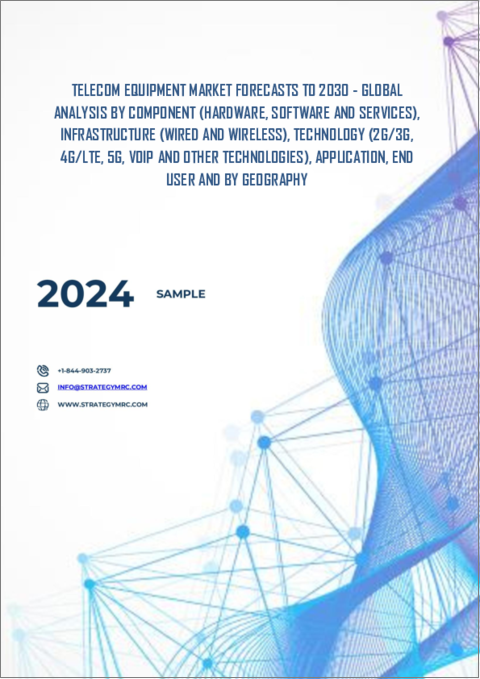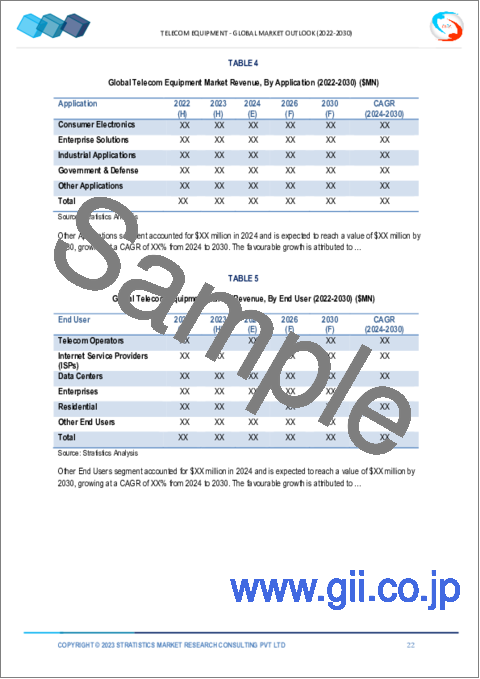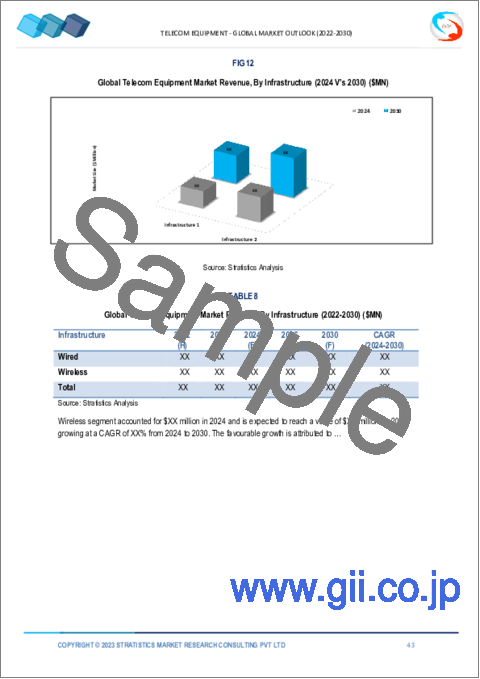|
|
市場調査レポート
商品コード
1530868
通信機器市場の2030年までの予測:コンポーネント別、インフラ別、技術別、用途別、エンドユーザー別、地域別の世界分析Telecom Equipment Market Forecasts to 2030 - Global Analysis By Component (Hardware, Software and Services), Infrastructure (Wired and Wireless), Technology (2G/3G, 4G/LTE, 5G, VoIP and Other Technologies), Application, End User and By Geography |
||||||
カスタマイズ可能
|
|||||||
| 通信機器市場の2030年までの予測:コンポーネント別、インフラ別、技術別、用途別、エンドユーザー別、地域別の世界分析 |
|
出版日: 2024年08月01日
発行: Stratistics Market Research Consulting
ページ情報: 英文 200+ Pages
納期: 2~3営業日
|
全表示
- 概要
- 図表
- 目次
Stratistics MRCによると、世界の通信機器市場は2024年に7,624億米ドルを占め、2030年には1兆876億米ドルに達し、予測期間中のCAGRは6.1%で成長すると予測されています。
通信機器には、通信目的で使用される幅広いハードウェアと技術が含まれます。これには、ルーター、スイッチ、伝送回線、衛星、基地トランシーバー局、その他様々なネットワークでデータ、音声、映像を伝送するのに不可欠なインフラなどの機器が含まれます。主要コンポーネントには、有線・無線システム、光ファイバー、ネットワーク機器などがあります。通信機器は、消費者環境と企業環境の両方において、接続性を確保し、通信ネットワークの運用をサポートするために不可欠です。
世界・システム・フォー・モバイル・コミュニケーションズ・アソシエーション(GSMA)の報告書によると、5Gネットワークは2025年までに世界人口の3分の1をカバーすると予測されています。GSMAは、通信事業者が2020年から2025年にかけてモバイルCAPEXに世界全体で約1兆1,000億米ドルを投資し、この投資の80%が5Gネットワークに充てられると推定しており、高度な通信機器の需要を促進しています。
データ消費の増加
国際通信連合(ITU)によると、世界のデータ消費量は2022年の340万ペタバイト(PB)から、2027年には3倍近い970万PBになると予想されています。この急増は、スマートフォンの普及、ビデオストリーミング、IoTデバイス、5Gネットワークの展開によってもたらされます。高速インターネットとデータ集約型アプリケーションの需要増加により、ネットワーク容量、速度、信頼性を強化するための先進的な通信機器への継続的な投資が必要となり、それによって市場成長が促進されます。
データ消費の増加
先進的な通信インフラ、特に5Gネットワークの導入と維持に関連する高コストは、大きな抑制要因となっています。PwCによると、通信事業者は2027年までにネットワークに3,421億米ドルを投資すると予測されています。こうした多額の設備投資は、頻繁なアップグレードやメンテナンスの必要性と相まって、特に小規模な事業者にとっては財源を圧迫しかねないです。さらに、接続サービスのコモディティ化によって価格決定力が制限され、これらの投資を迅速に回収することが難しくなっています。
ネットワークカバレッジの拡大
ネットワークカバレッジの拡大、特にサービスが行き届いていない地域や農村部での拡大は、通信機器市場にとって大きなチャンスです。国際電気通信連合(ITU)の推計によると、世界全体で約30億人が未接続の状態にあります。デジタル・インディア・プログラムや国家ブロードバンド・ミッションのようなイニシアチブは、ネットワーク・インフラを強化することで、このデジタル・デバイドを埋めることを目的としています。カバレッジの拡大は、顧客ベースを拡大するだけでなく、タワー、光ファイバーケーブル、無線通信機器などの通信機器の需要をも促進します。
激しい競合
電気通信分野における激しい競合は、市場プレーヤーの脅威となっています。電気通信業界は、競争力のある価格と革新的なサービスを提供しようとする新規参入者や既存事業者からの圧力に直面しています。こうした競争は価格競争につながり、利益率を低下させ、企業の経営維持や新技術への投資を困難にします。さらに、技術進歩のペースが速いため、先を行くためには継続的な技術革新が必要となり、競合圧力はさらに強まっています。
COVID-19の影響:
COVID-19の大流行は、通信インフラの重要性を浮き彫りにしました。国際金融公社(IFC)によると、在宅勤務やデジタル・サービスに依存する人が増えたため、この分野ではデータ・トラフィックとブロードバンド利用が増加しました。しかし、サプライチェーンの混乱や業務の複雑化が課題となっていました。こうしたハードルにもかかわらず、パンデミックはデジタル技術の採用を加速させ、リモートワークとデジタル接続をサポートする堅牢な通信機器の必要性を浮き彫りにしました。
予測期間中、ハードウェア分野が最大になる見込み
ハードウェア分野は、通信インフラにおける基本的な役割を担っているため、予測期間中に最大となる見込みです。これには、ネットワーク機器、伝送機器、無線通信機器、通信インフラが含まれます。通信ネットワークのバックボーンとして、ハードウェアコンポーネントは、データトラフィックの増加や5Gのような先進技術をサポートできる堅牢で大容量のネットワークの構築と維持に不可欠です。
予測期間中、5GセグメントのCAGRが最も高くなると予想されます。
5Gセグメントは予測期間中、最も高いCAGRが見込まれています。GSMA(Global System for Mobile Communications Association)によると、5Gネットワークは2025年までに世界人口の3分の1をカバーすると予測されています。5G技術の導入は、優れた速度、低遅延、IoTやその他の高度なアプリケーションをサポートする能力を提供します。このため、基地局、アンテナ、スモールセルなど、5G対応の通信機器に対する需要は大きいです。
最大シェアの地域:
予測期間中、北米地域が通信機器市場を独占すると予想されます。この優位性は、通信インフラへの投資の高さ、5Gのような先進技術の早期導入、大手通信会社の存在によるものです。また、北米の通信業界は、強力な財源と支援的な規制環境の恩恵を受けており、ネットワーク機能の継続的な進歩を促進しています。
CAGRが最も高い地域:
予測期間中、アジア太平洋地域は通信機器市場の急成長が見込まれます。この地域の成長の原動力は、通信インフラへの投資の増加、5Gネットワークの展開、中国やインドなどの国々におけるインターネットユーザーの増加です。この地域のデジタル経済の拡大と高速接続に対する消費者の需要の高まりが、さらに高い成長率に寄与しています。
無料のカスタマイズサービス:
本レポートをご購読のお客様には、以下の無料カスタマイズオプションのいずれかをご利用いただけます:
- 企業プロファイル
- 追加市場プレーヤーの包括的プロファイリング(3社まで)
- 主要企業のSWOT分析(3社まで)
- 地域セグメンテーション
- 顧客の関心に応じた主要国の市場推計・予測・CAGR(注:フィージビリティチェックによる)
- 競合ベンチマーキング
- 製品ポートフォリオ、地理的プレゼンス、戦略的提携に基づく主要企業のベンチマーキング
目次
第1章 エグゼクティブサマリー
第2章 序文
- 概要
- ステークホルダー
- 調査範囲
- 調査手法
- データマイニング
- データ分析
- データ検証
- 調査アプローチ
- 調査情報源
- 1次調査情報源
- 2次調査情報源
- 前提条件
第3章 市場動向分析
- 促進要因
- 抑制要因
- 機会
- 脅威
- 技術分析
- 用途分析
- エンドユーザー分析
- 新興市場
- COVID-19の影響
第4章 ポーターのファイブフォース分析
- 供給企業の交渉力
- 買い手の交渉力
- 代替品の脅威
- 新規参入業者の脅威
- 競争企業間の敵対関係
第5章 世界の通信機器市場:コンポーネント別
- ハードウェア
- ネットワーク機器
- ルーター
- スイッチ
- ゲートウェイ
- ブリッジ
- その他のネットワーク機器
- 伝送装置
- 光ファイバーケーブル
- 同軸ケーブル
- マイクロ波伝送
- 衛星放送
- その他の伝送機器
- 無線通信機器
- モバイルデバイス
- 基地局
- アンテナ
- リピーター
- その他の無線通信機器
- 通信インフラ
- タワー
- データセンター
- 小型セル
- その他の通信インフラ
- ネットワーク機器
- ソフトウェア
- ネットワーク管理ソフトウェア
- ネットワークパフォーマンス管理
- 障害管理
- 構成管理
- セキュリティ管理
- 運用サポートシステム(OSS)
- ビジネスサポートシステム(BSS)
- コミュニケーションソフトウェア
- セキュリティソフトウェア
- ネットワーク管理ソフトウェア
- サービス
- 設置および保守サービス
- コンサルティングサービス
- マネージドサービス
第6章 世界の通信機器市場:インフラ別
- 有線
- 無線
第7章 世界の通信機器市場:技術別
- 2G/3G
- 4G/LTE
- 5G
- ボイスメール
- その他の技術
第8章 世界の通信機器市場:用途別
- 家電
- エンタープライズソリューション
- 産業用途
- 政府と防衛
- その他の用途
第9章 世界の通信機器市場:エンドユーザー別
- 通信事業者
- インターネットサービスプロバイダー(ISP)
- データセンター
- 企業
- 住宅
- その他のエンドユーザー
第10章 世界の通信機器市場:地域別
- 北米
- 米国
- カナダ
- メキシコ
- 欧州
- ドイツ
- 英国
- イタリア
- フランス
- スペイン
- その他欧州
- アジア太平洋
- 日本
- 中国
- インド
- オーストラリア
- ニュージーランド
- 韓国
- その他アジア太平洋地域
- 南米
- アルゼンチン
- ブラジル
- チリ
- その他南米
- 中東・アフリカ
- サウジアラビア
- アラブ首長国連邦
- カタール
- 南アフリカ
- その他中東とアフリカ
第11章 主な発展
- 契約、パートナーシップ、コラボレーション、合弁事業
- 買収と合併
- 新製品発売
- 事業拡大
- その他の主要戦略
第12章 企業プロファイリング
- Huawei Technologies Co. Ltd
- Nokia Corporation
- Ericsson
- ZTE Corporation
- Cisco Systems
- Samsung Electronics Co.
- Ciena Corporation
- Fujitsu Limited
- Juniper Networks, Inc.
- NEC Corporation
- CommScope Holding Company, Inc.
- Adtran
- Infinera
- Arris International Limited
- Qualcomm Technologies, Inc.
- Ribbon Communications Operating Company, Inc.
- FiberHome Technologies
- Extreme Networks, Inc.
List of Tables
- Table 1 Global Telecom Equipment Market Outlook, By Region (2022-2030) ($MN)
- Table 2 Global Telecom Equipment Market Outlook, By Component (2022-2030) ($MN)
- Table 3 Global Telecom Equipment Market Outlook, By Hardware (2022-2030) ($MN)
- Table 4 Global Telecom Equipment Market Outlook, By Networking Equipment (2022-2030) ($MN)
- Table 5 Global Telecom Equipment Market Outlook, By Transmission Equipment (2022-2030) ($MN)
- Table 6 Global Telecom Equipment Market Outlook, By Wireless Communication Equipment (2022-2030) ($MN)
- Table 7 Global Telecom Equipment Market Outlook, By Telecommunications Infrastructure (2022-2030) ($MN)
- Table 8 Global Telecom Equipment Market Outlook, By Software (2022-2030) ($MN)
- Table 9 Global Telecom Equipment Market Outlook, By Network Management Software (2022-2030) ($MN)
- Table 10 Global Telecom Equipment Market Outlook, By Operational Support Systems (OSS) (2022-2030) ($MN)
- Table 11 Global Telecom Equipment Market Outlook, By Business Support Systems (BSS) (2022-2030) ($MN)
- Table 12 Global Telecom Equipment Market Outlook, By Communication Software (2022-2030) ($MN)
- Table 13 Global Telecom Equipment Market Outlook, By Security Software (2022-2030) ($MN)
- Table 14 Global Telecom Equipment Market Outlook, By Services (2022-2030) ($MN)
- Table 15 Global Telecom Equipment Market Outlook, By Installation and Maintenance Services (2022-2030) ($MN)
- Table 16 Global Telecom Equipment Market Outlook, By Consulting Services (2022-2030) ($MN)
- Table 17 Global Telecom Equipment Market Outlook, By Managed Services (2022-2030) ($MN)
- Table 18 Global Telecom Equipment Market Outlook, By Infrastructure (2022-2030) ($MN)
- Table 19 Global Telecom Equipment Market Outlook, By Wired (2022-2030) ($MN)
- Table 20 Global Telecom Equipment Market Outlook, By Wireless (2022-2030) ($MN)
- Table 21 Global Telecom Equipment Market Outlook, By Technology (2022-2030) ($MN)
- Table 22 Global Telecom Equipment Market Outlook, By 2G/3G (2022-2030) ($MN)
- Table 23 Global Telecom Equipment Market Outlook, By 4G/LTE (2022-2030) ($MN)
- Table 24 Global Telecom Equipment Market Outlook, By 5G (2022-2030) ($MN)
- Table 25 Global Telecom Equipment Market Outlook, By VoIP (2022-2030) ($MN)
- Table 26 Global Telecom Equipment Market Outlook, By Other Technologies (2022-2030) ($MN)
- Table 27 Global Telecom Equipment Market Outlook, By Application (2022-2030) ($MN)
- Table 28 Global Telecom Equipment Market Outlook, By Consumer Electronics (2022-2030) ($MN)
- Table 29 Global Telecom Equipment Market Outlook, By Enterprise Solutions (2022-2030) ($MN)
- Table 30 Global Telecom Equipment Market Outlook, By Industrial Applications (2022-2030) ($MN)
- Table 31 Global Telecom Equipment Market Outlook, By Government & Defense (2022-2030) ($MN)
- Table 32 Global Telecom Equipment Market Outlook, By Other Applications (2022-2030) ($MN)
- Table 33 Global Telecom Equipment Market Outlook, By End User (2022-2030) ($MN)
- Table 34 Global Telecom Equipment Market Outlook, By Telecom Operators (2022-2030) ($MN)
- Table 35 Global Telecom Equipment Market Outlook, By Internet Service Providers (ISPs) (2022-2030) ($MN)
- Table 36 Global Telecom Equipment Market Outlook, By Data Centers (2022-2030) ($MN)
- Table 37 Global Telecom Equipment Market Outlook, By Enterprises (2022-2030) ($MN)
- Table 38 Global Telecom Equipment Market Outlook, By Residential (2022-2030) ($MN)
- Table 39 Global Telecom Equipment Market Outlook, By Other End Users (2022-2030) ($MN)
Note: Tables for North America, Europe, APAC, South America, and Middle East & Africa Regions are also represented in the same manner as above.
According to Stratistics MRC, the Global Telecom Equipment Market is accounted for $762.4 billion in 2024 and is expected to reach $1,087.6 billion by 2030, growing at a CAGR of 6.1% during the forecast period. Telecom equipment encompasses a wide range of hardware and technologies used for communication purposes. This includes devices such as routers, switches, transmission lines, satellites, base transceiver stations, and other infrastructure essential for transmitting data, voice, and video across various networks. Key components include wired and wireless systems, fiber optics, and networking devices. Telecom equipment is vital for ensuring connectivity and supporting the operation of telecommunication networks in both consumer and enterprise environment.
According to a report by the Global System for Mobile Communications Association (GSMA), 5G networks are projected to cover one-third of the world's population by 2025. The GSMA estimates that operators will invest around $1.1 trillion globally in mobile CAPEX between 2020 and 2025, with 80% of this investment dedicated to 5G networks, driving demand for advanced telecom equipment.
Market Dynamics:
Driver:
Increasing data consumption
According to the International Telecommunication Union (ITU), global data consumption is expected to nearly triple from 3.4 million petabytes (PB) in 2022 to 9.7 million PB by 2027. This surge is driven by the proliferation of smartphones, video streaming, IoT devices, and the rollout of 5G networks. The increasing demand for high-speed internet and data-intensive applications necessitates continuous investment in advanced telecom equipment to enhance network capacity, speed, and reliability, thereby driving market growth.
Restraint:
Increasing data consumption
The high costs associated with deploying and maintaining advanced telecom infrastructure, particularly for 5G networks, pose a significant restraint. According to PwC, telecom operators are projected to invest $342.1 billion in their networks by 2027. These substantial capital expenditures, coupled with the need for frequent upgrades and maintenance, can strain financial resources, especially for smaller operators. Additionally, the commoditization of connectivity services limits pricing power, making it challenging to recover these investments quickly.
Opportunity:
Expanding network coverage
Expanding network coverage, especially in underserved and rural areas, presents a significant opportunity for the telecom equipment market. The International Telecommunication Union (ITU) estimates that around 3 billion people globally remain unconnected. Initiatives like the Digital India program and the National Broadband Mission aim to bridge this digital divide by enhancing network infrastructure. Expanding coverage not only increases the customer base but also drives demand for telecom equipment, including towers, fiber-optic cables, and wireless communication devices.
Threat:
Intense competition
Intense competition in the telecom sector poses a threat to market players. The telecom industry faces pressure from new entrants and existing players striving to offer competitive pricing and innovative services. This competition can lead to price wars, reducing profit margins, and making it challenging for companies to sustain operations and invest in new technologies. Additionally, the rapid pace of technological advancements requires continuous innovation to stay ahead, further intensifying competitive pressures.
Covid-19 Impact:
The COVID-19 pandemic underscored the critical importance of telecommunications infrastructure. According to the International Finance Corporation (IFC), the sector saw increased data traffic and broadband usage as more people worked from home and relied on digital services. However, supply chain disruptions and increased operational complexities posed challenges. Despite these hurdles, the pandemic accelerated the adoption of digital technologies, highlighting the need for robust telecom equipment to support remote work and digital connectivity.
The hardware segment is expected to be the largest during the forecast period
The hardware segment is expected to be the largest during the forecast period due to its fundamental role in telecom infrastructure. This includes networking equipment, transmission equipment, wireless communication devices, and telecommunications infrastructure. As the backbone of telecom networks, hardware components are essential for building and maintaining robust, high-capacity networks capable of supporting increasing data traffic and advanced technologies like 5G.
The 5G segment is expected to have the highest CAGR during the forecast period
The 5G segment is expected to have the highest CAGR during the forecast period. According to the Global System for Mobile Communications Association (GSMA), 5G networks are projected to cover one-third of the world's population by 2025. The deployment of 5G technology offers superior speed, low latency, and the capacity to support IoT and other advanced applications. This drives significant demand for 5G-compatible telecom equipment, including base stations, antennas, and small cells.
Region with largest share:
During the forecast period, the North American region is expected to dominate the telecom equipment market. This dominance is attributed to high investment in telecom infrastructure, early adoption of advanced technologies like 5G, and the presence of major telecom companies. In addition, North America's telecom industry benefits from strong financial resources and a supportive regulatory environment, driving continuous advancements in network capabilities.
Region with highest CAGR:
During the forecast period, the Asia Pacific region is expected to witness rapid growth in the telecom equipment market. The region's growth is driven by increasing investments in telecom infrastructure, the rollout of 5G networks, and the growing number of internet users in countries like China and India. The region's expanding digital economy and rising consumer demand for high-speed connectivity further contribute to its high growth rate.
Key players in the market
Some of the key players in Telecom Equipment market include Huawei Technologies Co. Ltd, Nokia Corporation, Ericsson, ZTE Corporation, Cisco Systems, Samsung Electronics Co., Ciena Corporation, Fujitsu Limited, Juniper Networks, Inc., NEC Corporation, CommScope Holding Company, Inc., Adtran, Infinera, Arris International Limited, Qualcomm Technologies, Inc., Ribbon Communications Operating Company, Inc., FiberHome Technologies, and Extreme Networks, Inc.
Key Developments:
In July 2024, Nokia expanded its Fixed Wireless Access (FWA) portfolio with new 5G devices for the North American market and launched Broadband Easy Connect to simplify fiber home connections.
In June 2024, Ericsson won the Red Dot Design Award for its innovative Radio 4471 and Streetmacro 6705, recognizing excellence in industrial design and user experience.
In February 2024, Huawei showcased its 5.5G products and solutions at MWC Barcelona 2024, emphasizing the future of intelligent digital transformation and network-cloud-intelligence synergy.
Components Covered:
- Hardware
- Software
- Services
Infrastructures Covered:
- Wired
- Wireless
Technologies Covered:
- 2G/3G
- 4G/LTE
- 5G
- VoIP
- Other Technologies
Applications Covered:
- Consumer Electronics
- Enterprise Solutions
- Industrial Applications
- Government & Defense
- Other Applications
End Users Covered:
- Telecom Operators
- Internet Service Providers (ISPs)
- Data Centers
- Enterprises
- Residential
- Other End Users
Regions Covered:
- North America
- US
- Canada
- Mexico
- Europe
- Germany
- UK
- Italy
- France
- Spain
- Rest of Europe
- Asia Pacific
- Japan
- China
- India
- Australia
- New Zealand
- South Korea
- Rest of Asia Pacific
- South America
- Argentina
- Brazil
- Chile
- Rest of South America
- Middle East & Africa
- Saudi Arabia
- UAE
- Qatar
- South Africa
- Rest of Middle East & Africa
What our report offers:
- Market share assessments for the regional and country-level segments
- Strategic recommendations for the new entrants
- Covers Market data for the years 2022, 2023, 2024, 2026, and 2030
- Market Trends (Drivers, Constraints, Opportunities, Threats, Challenges, Investment Opportunities, and recommendations)
- Strategic recommendations in key business segments based on the market estimations
- Competitive landscaping mapping the key common trends
- Company profiling with detailed strategies, financials, and recent developments
- Supply chain trends mapping the latest technological advancements
Free Customization Offerings:
All the customers of this report will be entitled to receive one of the following free customization options:
- Company Profiling
- Comprehensive profiling of additional market players (up to 3)
- SWOT Analysis of key players (up to 3)
- Regional Segmentation
- Market estimations, Forecasts and CAGR of any prominent country as per the client's interest (Note: Depends on feasibility check)
- Competitive Benchmarking
- Benchmarking of key players based on product portfolio, geographical presence, and strategic alliances
Table of Contents
1 Executive Summary
2 Preface
- 2.1 Abstract
- 2.2 Stake Holders
- 2.3 Research Scope
- 2.4 Research Methodology
- 2.4.1 Data Mining
- 2.4.2 Data Analysis
- 2.4.3 Data Validation
- 2.4.4 Research Approach
- 2.5 Research Sources
- 2.5.1 Primary Research Sources
- 2.5.2 Secondary Research Sources
- 2.5.3 Assumptions
3 Market Trend Analysis
- 3.1 Introduction
- 3.2 Drivers
- 3.3 Restraints
- 3.4 Opportunities
- 3.5 Threats
- 3.6 Technology Analysis
- 3.7 Application Analysis
- 3.8 End User Analysis
- 3.9 Emerging Markets
- 3.10 Impact of Covid-19
4 Porters Five Force Analysis
- 4.1 Bargaining power of suppliers
- 4.2 Bargaining power of buyers
- 4.3 Threat of substitutes
- 4.4 Threat of new entrants
- 4.5 Competitive rivalry
5 Global Telecom Equipment Market, By Component
- 5.1 Introduction
- 5.2 Hardware
- 5.2.1 Networking Equipment
- 5.2.1.1 Routers
- 5.2.1.2 Switches
- 5.2.1.3 Gateways
- 5.2.1.4 Bridges
- 5.2.1.5 Other Networking Equipment
- 5.2.2 Transmission Equipment
- 5.2.2.1 Fiber Optic Cables
- 5.2.2.2 Coaxial Cables
- 5.2.2.3 Microwave Transmission
- 5.2.2.4 Satellite Transmission
- 5.2.2.5 Other Transmission Equipment
- 5.2.3 Wireless Communication Equipment
- 5.2.3.1 Mobile Devices
- 5.2.3.2 Base Stations
- 5.2.3.3 Antennas
- 5.2.3.4 Repeaters
- 5.2.3.5 Other Wireless Communication Equipment
- 5.2.4 Telecommunications Infrastructure
- 5.2.4.1 Towers
- 5.2.4.2 Data Centers
- 5.2.4.3 Small Cells
- 5.2.4.4 Other Telecommunications Infrastructure
- 5.2.1 Networking Equipment
- 5.3 Software
- 5.3.1 Network Management Software
- 5.3.1.1 Network Performance Management
- 5.3.1.2 Fault Management
- 5.3.1.3 Configuration Management
- 5.3.1.4 Security Management
- 5.3.2 Operational Support Systems (OSS)
- 5.3.3 Business Support Systems (BSS)
- 5.3.4 Communication Software
- 5.3.5 Security Software
- 5.3.1 Network Management Software
- 5.4 Services
- 5.4.1 Installation and Maintenance Services
- 5.4.2 Consulting Services
- 5.4.3 Managed Services
6 Global Telecom Equipment Market, By Infrastructure
- 6.1 Introduction
- 6.2 Wired
- 6.3 Wireless
7 Global Telecom Equipment Market, By Technology
- 7.1 Introduction
- 7.2 2G/3G
- 7.3 4G/LTE
- 7.4 5G
- 7.5 VoIP
- 7.6 Other Technologies
8 Global Telecom Equipment Market, By Application
- 8.1 Introduction
- 8.2 Consumer Electronics
- 8.3 Enterprise Solutions
- 8.4 Industrial Applications
- 8.5 Government & Defense
- 8.6 Other Applications
9 Global Telecom Equipment Market, By End User
- 9.1 Introduction
- 9.2 Telecom Operators
- 9.3 Internet Service Providers (ISPs)
- 9.4 Data Centers
- 9.5 Enterprises
- 9.6 Residential
- 9.7 Other End Users
10 Global Telecom Equipment Market, By Geography
- 10.1 Introduction
- 10.2 North America
- 10.2.1 US
- 10.2.2 Canada
- 10.2.3 Mexico
- 10.3 Europe
- 10.3.1 Germany
- 10.3.2 UK
- 10.3.3 Italy
- 10.3.4 France
- 10.3.5 Spain
- 10.3.6 Rest of Europe
- 10.4 Asia Pacific
- 10.4.1 Japan
- 10.4.2 China
- 10.4.3 India
- 10.4.4 Australia
- 10.4.5 New Zealand
- 10.4.6 South Korea
- 10.4.7 Rest of Asia Pacific
- 10.5 South America
- 10.5.1 Argentina
- 10.5.2 Brazil
- 10.5.3 Chile
- 10.5.4 Rest of South America
- 10.6 Middle East & Africa
- 10.6.1 Saudi Arabia
- 10.6.2 UAE
- 10.6.3 Qatar
- 10.6.4 South Africa
- 10.6.5 Rest of Middle East & Africa
11 Key Developments
- 11.1 Agreements, Partnerships, Collaborations and Joint Ventures
- 11.2 Acquisitions & Mergers
- 11.3 New Product Launch
- 11.4 Expansions
- 11.5 Other Key Strategies
12 Company Profiling
- 12.1 Huawei Technologies Co. Ltd
- 12.2 Nokia Corporation
- 12.3 Ericsson
- 12.4 ZTE Corporation
- 12.5 Cisco Systems
- 12.6 Samsung Electronics Co.
- 12.7 Ciena Corporation
- 12.8 Fujitsu Limited
- 12.9 Juniper Networks, Inc.
- 12.10 NEC Corporation
- 12.11 CommScope Holding Company, Inc.
- 12.12 Adtran
- 12.13 Infinera
- 12.14 Arris International Limited
- 12.15 Qualcomm Technologies, Inc.
- 12.16 Ribbon Communications Operating Company, Inc.
- 12.17 FiberHome Technologies
- 12.18 Extreme Networks, Inc.






